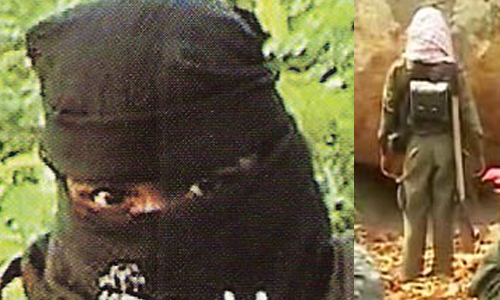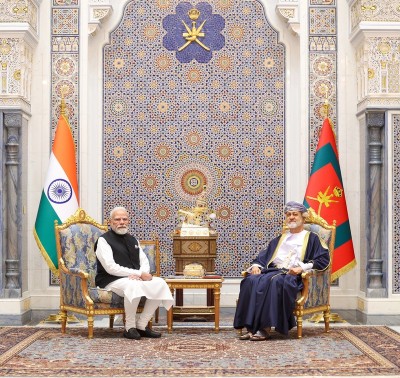
Maoists: Penetrating Intelligence
On September 25, the Chhattisgarh Police arrested seven 'Maoist suppliers' and seized 1,750 kilograms of explosives in the restive region. The seizures included 750 kilograms of Gelatin, 1,000 kilograms of Ammonium Nitrate, a big bundle of Cordex wire, eight fake number plates of four-wheelers and three cars being used to supply the material to the Maoists, from two locations, and arrested Gourishankar Mohanty, Anil Kumar Jena, Bhushan Kumar Gonda, Rajendra, Uttam Swain and Sujit Pani, along with Kamalkant Swain, a mining engineer. All of them were from Odisha. According to a statement by the Police, they had been tracking a network of urban Maoist suppliers for a long time. A few days before the arrests, Police received information that Kamalkant would be meeting the Maoist leader of the Darbha area, Vinod, to strike a supply deal. A trap was laid on the Darbha-Pakhnar Road. Kamalkant, Gourishankar Mohanty, Anil Kumar Jena and Bhushan Kumar Gonda, who were transporting the explosives in a pick-up vehicle, were arrested. After interrogation, Kamalkant told the Police about another consignment that was being delivered to the Maoists in Nagarnar. Another trap was laid near Markot Tiria and Rajendra, Uttam Swain and Sujit Pani were arrested, and 20 bags of ammonium nitrate and two vehicles were seized.
On September 19, Sonadhar, the secretary of the CPI-Maoist's Kanger Valley 'area committee' was killed along with two other cadres of the Darbha Division (in Bastar, Chhattisgarh) by the Odisha Police, in an encounter near Kotaguda village in the Malkangiri District of Odisha, close to the Darbha area of Chhattisgarh. Sonadhar was instrumental in the Darbha Valley attack on the Congress party convoy on May 25, 2013, in which at least 27 people, including Mahendra Karma, some senior Congress leaders and 10 Security Force (SF) personnel, were killed. Sonadhar also played a major role in the Tahakwada Maoist ambush in March 2014, which resulted in the killing of 16 people, including 11 Central Reserve Police Force (CRPF) personnel. A reward of INR 500,000 had been declared against him by the Odisha Police and another INR 800,000 by the Chhattisgarh Police.
According Police sources, Sonadhar had lately become complacent, believing that the Odisha Police were not very active, especially in border areas close to Chhattisgarh. He used to move around on bicycles with an AK-47 and an UBGL in many border villages. On September 19, Odisha Police received intelligence inputs regarding his presence in a village market. Sonadhar and another two Maoists were killed in the subsequent encounter.
Earlier, two CPI-Maoist cadres, identified as Sruthi alias Mahitha (23), native of Waddepally, Hanamkonda and an engineering graduate, and Vidyasagar Reddyalias Sagar (32), native of Dharmasagar mandal of Warangal District, were killed in an encounter with the Police in the Vengayapally area of Tadwai mandal in the Warangal District of Telangana on September 15. It is suspected that the CPI-Maoist Karimnagar-Khammam-Warangal (KKW) 'divisional secretary' Damodar and several others managed to escape from the spot. Police recovered two weapons - one .303 and a carbine - and several kit bags, from the scene.
Sruthi's parents, Sudarshanam and Rama Devi, alleged that their daughter was killed in a fake encounter. They told the media that their daughter was arrested, tortured and killed in a cruel manner by the Police. "She joined the Maoists to achieve people's Telangana and to fight for the poor Adivasis. Chief Minister K. Chandrasekhar Rao, Ministers and the Police should own responsibility for her death," Sudarshanam said. The parents of Vidyasagar Reddy remained silent over the death of their son. Sagar, who had passed the tenth class, used to work as a car driver and worked with a private seeds company before joining the Maoist party just a month earlier, the parents disclosed.
Though the incident was widely discussed in the media, highlighting it as the first 'encounter' against the Maoists in Telangana State since its formation, in an earlier incident on December 14, 2014, a suspected CPI-Maoist cadre, identified as Karam Narasimha Rao, was killed and another person was injured in a clash with the Police in the Cherla mandal of Khammam District. The latest incident has, however, dispelled perception that the Telangana Rashtra Samithi (TRS) Government in Telangana was 'soft' towards the Maoists. Significantly, at least seven members of the 'KKW divisional committee; were killed in an intelligence-based operation by the Andhra Pradesh Police Greyhounds on April 16, 2013, a few kilometres across the border, in Chhattisgarh.
The three incidents clearly demonstrate better intelligence gathering in the core areas of Maoist activity, and also indicate a degree of 'softening' of the Maoist grip even in areas of earlier dominance. The incident in Odisha's Malkangiri District, in which Sonadhar was killed, moreover, came amidst a wave of Maoist surrenders in the District. Since September 1, 2015, 55 Maoists, including 11 village committee members, at least three Maoists carrying rewards, 40 described as cadres, and more than 800 'supporters', have surrendered before the District Police. Most of the surrenders are from the Podia Police Station limits, while some are from the Kalimela Police Station area of Malkangiri District.
The wave of Maoist surrenders in Malkangiri is reminiscent of the earlier surge of surrenders in the Narayanpatna area of Koraput and in the Bastar region ofChhattisgarh. In Narayanpatna more than 2,400 Maoists and their supporters had surrendered, including some armed cadre, but most of them active or passive supporters of the Chasi Mulia Adivasi Sangh (CMAS), a Maoist front organisation. This had a devastating impact on Maoist capabilities and dramatically reduced violence in the area. Koraput District, which used to be a very strong Maoist basehas recorded relatively low levels of violence, with just one Maoist-related fatality so far in 2015. Such a low level of violence in Koraput has not been seen, at least since 2008.
Similarly, though questions regarding the quality/significance of the surrenders in Bastar through 2014 were raised, there has been some improvement in the quality of arrests and surrenders and better targeting of Maoists in Chhattisgarh, indicating better intelligence flows. Thus, the SATP database indicates that the arrest, surrender or killing of Maoists above the cadre or supporter level in 2015 (data till September 27) stood at 39; 63 in 2014; 14 in 2013; 25 in 2012; 10 in 2011; and nine in 2010, clearly indicating improving trends in targeting the middle rungs of leadership. In the past, SFs had suffered significant losses as a result of deficient intelligence in the Maoist core areas, particularly the Bastar Division in Chhattisgarh and the Malkangiri and Koraput Districts of Odisha.
Despite these recent and rising successes, however, it is useful to note that none of the major arrests, surrenders or killings has been of the top level leadership. While Sonadhar has been described by the Odisha Police as the 'mastermind' of the Darbha attack, this conflicts with the National Investigation Agency's (NIA's) chargesheet, which indicates that Sonadhar played an active role in arranging eatables and other logistics for the Maoists, carried out a recce for the ambush, mobilised Janmilitia with domestic weapons as the local area committee secretary and participated in the attack. However, it was the "South Regional Unified Command (SRUC) of CPI (Maoist)" which hatched the conspiracy to carry out the attack, and cadres from 2nd Central Regional Command (CRC-2), military Coy No -2, Platoon No 24 & 26 operating in Darbha Division, and LGS/LOS members of the Darbha Division Committee, who carried out the attack under the overall Command of Barse Sukka aka Deva of the Darbha Divisional Committee.
The improving trends in SF dominance and the weakening hold of the Maoists is encouraging, and demonstrates better intelligence flows from the rebels' core areas, but the successful evasion by the Maoist leadership is an index of the long struggle that lies ahead.
Support Our Journalism
We cannot do without you.. your contribution supports unbiased journalism
IBNS is not driven by any ism- not wokeism, not racism, not skewed secularism, not hyper right-wing or left liberal ideals, nor by any hardline religious beliefs or hyper nationalism. We want to serve you good old objective news, as they are. We do not judge or preach. We let people decide for themselves. We only try to present factual and well-sourced news.






